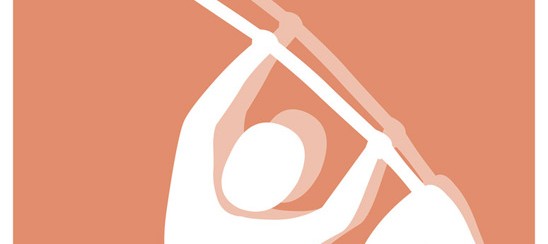One of the best pole vaulters in the world, Brad Walker currently holds the American outdoor record in the pole vault at 6.04m/19.975ft. Born in Spokane, Washington and a product of the University of Washington, Brad is a four-time World Championship medalist, a four-time USA Indoor Champion, and a two-time NCAA Indoor Champion. Brad recently sat down with Brent George of G4 Athlete to discuss his his physical and mental preparation for competition.
It’s All About Blood Flow
Brent George: To begin, I’d love to hear about the things you’ve learned in your journey. Let’s start in the medical arena. What have you found to work for you? What didn’t work for you?
Brad Walker: We could talk all day on this subject but to narrow it down, my approach toward therapy surrounds blood flow. Getting blood flow to all of your tissues is crucial. When you have a tight muscle, the muscle is being partially contracted. You’re losing blood flow to that area; and its ability to function at 100%.
If that happens for a long period of time, muscle tissue begins to fatigue; it starts getting weak; and loses elasticity. If you keep adding stress to that tissue, it can’t function the way it is suppose to because it doesn’t have the proper nutrients and blood flow supporting it. This leads to compensation from other muscles designed to do other jobs and can ultimately lead to injury.
For this reason, diet is really important to me. It keeps blood flowing in the body, helps tissue heal, and fuels all of our movements. You wouldn’t catch an F1 or NASCAR team using cheap fuel, and the same goes for athletes who want to succeed.
Dry-Needling
BG: What else do you do?
BW: I do a lot of acupuncture. I do a little bit of chiropractic. I also do massage. Those are my three biggest modalities I do on a weekly basis.
I’ve found over the last few years that my body, and quite frankly most people’s bodies, respond really well to acupuncture needles.
When people think of acupuncture, they think about Chinese medicine. I believe strongly in Chinese medicine, but I am specifically referencing to sport-related acupuncture, sometimes referred to as dry-needling. The technique targets tight tissue, finds trigger points in those muscles, and manipulates the needles while they are actually in the muscle. The needle hits the trigger, causing the muscle to spasm and then release. That’s kind of my go-to for almost anything, getting acupuncture.
After a jump session, my glutes, which are used as rotational stabilizers, start to freak out. They spasm—mostly on the right side if you take off on the left foot since your right knee drives up. As they tighten, and because of the attachment points, it causes a huge compression in the lower lumbar spine which is where I have had a lot of my injuries.
After a jump session, I’ll work through my glutes with needles and get them to almost fully relax. Coupled with a little massage and maybe a hot bath, I can get the tissue to melt away pretty effectively.
BG: Were you talking about augmented soft tissue release like ASTYM or Graston?
BW: Yes, I like most of the fascia work. I have some tools, and do some of the ancient Chinese version, gua sha. I did some Graston the other day and definitely noticed an increased range of motion but the smaller gua sha tools have a sharper edge and I seem to respond better to those tools.
A lot of times it just takes a therapist to figure out if there is a muscular issue or more of a fascial issue. Many times it’s both. Coupling both treatments together, doing the glute muscle work with needles and then the fascia work on top of it can really help open everything up. What it boils down to with all of these different techniques is that we’re trying to relax tissue and increase blood flow.
If you’re working on the fascia, you’re trying to break apart adhesions in the fascia tissue to get more blood in the area. I also do cupping quite a bit. It’s another modality for fascial therapy. It pulls the skin away from the body allowing more nutrients and oxygen into the tissue. I have had quite a bit of success with that technique as well.
Nutritional Approach
BG: You’ve talked about your work after a jump session. What about your preparations before a competition? Are there specific things that you’re doing to prepare for competition through your medical and nutritional approaches?
BW: Yep. My body is really sensitive to food. From an Eastern philosophy approach, different foods create warmth and cooling in the body. I like to try and warm the body up for a competition. So, I eat foods accordingly.
For example, lamb is a really warming meat so I’ll make lamb jerky often. When I eat lamb, I notice that my body feels a little bit looser, a bit more warm—more internal heat. From a dietary standpoint, I like to eat a lot of calories and make sure I am well-fueled. I want to make sure my fuel is topped off and stay with foods that don’t cool me down.
I couple my nutrition with therapy. I don’t like ice anymore—my body doesn’t like it. I used to do a lot of cold baths. I understand the theory about how ice creates constriction and then it creates a pump. If I use cold at all, it is in contrast with heat.
A lot of times before I go to a meet, I’ll take a really warm bath trying to open up all the tissues in my leg and lower back. I’ll try and sleep through the night making sure all of those tissues are opened up. Then, the day of the competition, I just try to stay warm, stretch, and stay limber.



